Resource Development: Inclusive Curriculum Design Theories Used
VerifiedAdded on 2023/06/11
|16
|3650
|440
Essay
AI Summary
This essay explores the utilization of learning and teaching resources to enhance student engagement and knowledge construction, emphasizing the importance of aligning resource design with diverse learning styles and brain functions. It delves into theories, principles, and models of inclusive curriculum design, particularly Gardner's multiple intelligences, to inform effective resource development. The essay also discusses the evolution of curriculum understanding, highlighting the shift towards lifelong learning and the significance of a well-defined curriculum framework. Examples of innovative resources like Hegarty Maths, (g)Math – EdTech, Desmos, and Prodigy Maths are presented, illustrating how technology can support diverse learning needs and improve student outcomes. The document is available on Desklib, a platform offering a range of AI-based study tools and solved assignments for students.

Introduction
Clay P. Bedford says that a student will learn a lesson for a day when they are taught,
but if curiosity of learning is taught to them, then they will continue the process of learning
for as long as they might live. He further states that resources are not only the various
teaching materials and the methods used, but also the time that is made available for
instruction, the skills of the teacher and the knowledge that is incurred through the training
process and teaching experience. Learning resources is defined as any individual or material
which may have been acquired or been produced locally, which content or function that is
instructional and can be used for both formal and informal teaching and learning. Learning
resources can include print and non-print materials; audio, visual, electronic and digital
hardware or software resources and human resources. If the learning and teaching resources
are used effectively then it can benefit the students into constructing knowledge on their own
and also develop various effective learning strategies, values, attitudes, generic skills and
hence lays a foundation for a long learning process.
Links to various websites which can provide extra resources of a topic that is being
discussed or creates a platform for student learning can be available via Blackboard.
Clay P. Bedford says that a student will learn a lesson for a day when they are taught,
but if curiosity of learning is taught to them, then they will continue the process of learning
for as long as they might live. He further states that resources are not only the various
teaching materials and the methods used, but also the time that is made available for
instruction, the skills of the teacher and the knowledge that is incurred through the training
process and teaching experience. Learning resources is defined as any individual or material
which may have been acquired or been produced locally, which content or function that is
instructional and can be used for both formal and informal teaching and learning. Learning
resources can include print and non-print materials; audio, visual, electronic and digital
hardware or software resources and human resources. If the learning and teaching resources
are used effectively then it can benefit the students into constructing knowledge on their own
and also develop various effective learning strategies, values, attitudes, generic skills and
hence lays a foundation for a long learning process.
Links to various websites which can provide extra resources of a topic that is being
discussed or creates a platform for student learning can be available via Blackboard.
Paraphrase This Document
Need a fresh take? Get an instant paraphrase of this document with our AI Paraphraser

Aim of utilizing learning and teaching resources
Teachers use various methods to engage the students in the learning of the curriculum which
is outlined for them. The introduction of new technologies and physiological resources can
help the students into realizing their strengths and helping them to get engaged in the process
of learning. The aim of utilizing the learning and teaching resources are:
1. Helps to give economy in speech and time
2. Helps to make the course easy
3. Helps in making the course clear
4. Helps in increasing the motivation and interest of students
5. Helps in simplifying the complex explanations
6. Helps in creating an interest for learning
Teachers use various methods to engage the students in the learning of the curriculum which
is outlined for them. The introduction of new technologies and physiological resources can
help the students into realizing their strengths and helping them to get engaged in the process
of learning. The aim of utilizing the learning and teaching resources are:
1. Helps to give economy in speech and time
2. Helps to make the course easy
3. Helps in making the course clear
4. Helps in increasing the motivation and interest of students
5. Helps in simplifying the complex explanations
6. Helps in creating an interest for learning
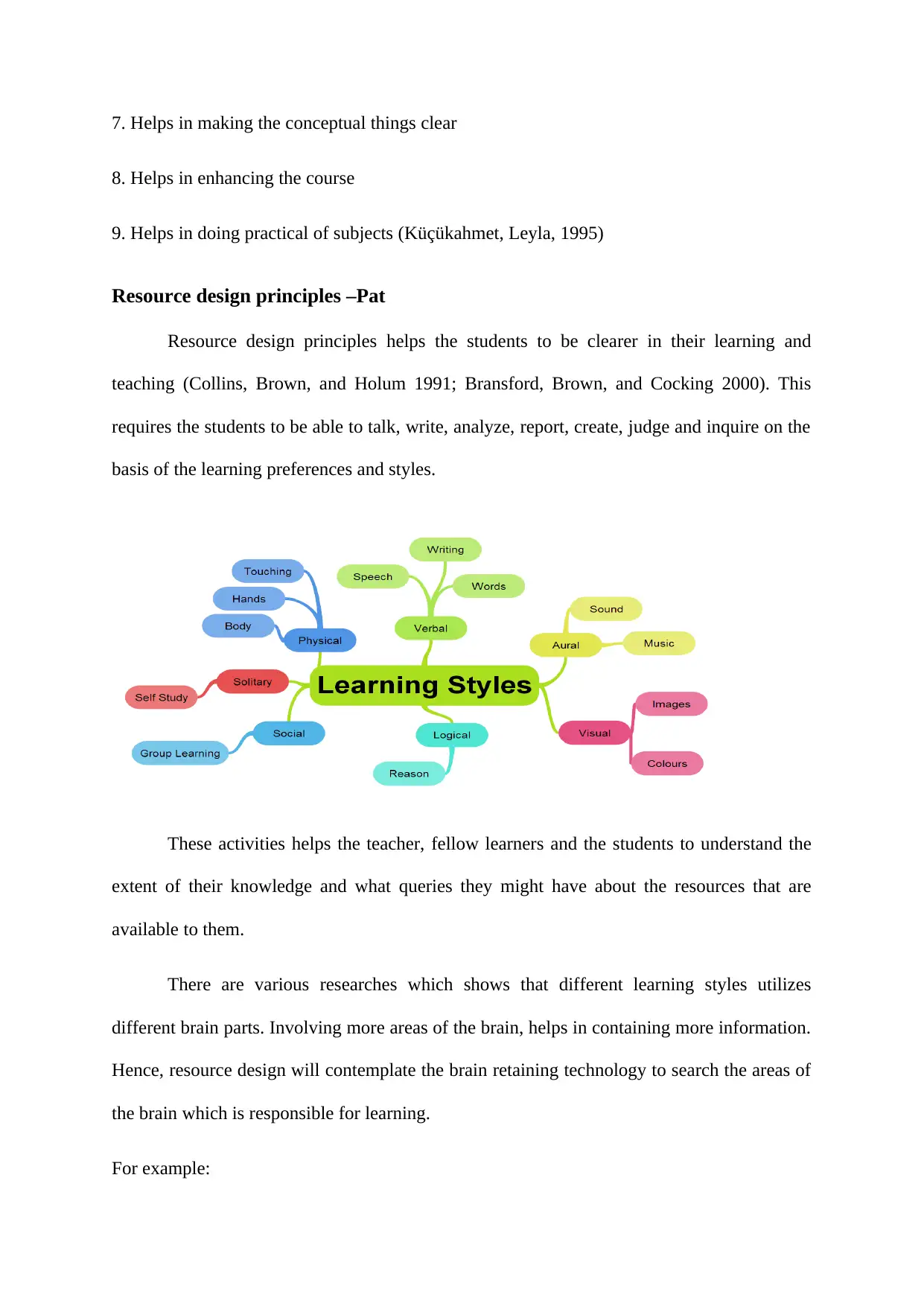
7. Helps in making the conceptual things clear
8. Helps in enhancing the course
9. Helps in doing practical of subjects (Küçükahmet, Leyla, 1995)
Resource design principles –Pat
Resource design principles helps the students to be clearer in their learning and
teaching (Collins, Brown, and Holum 1991; Bransford, Brown, and Cocking 2000). This
requires the students to be able to talk, write, analyze, report, create, judge and inquire on the
basis of the learning preferences and styles.
These activities helps the teacher, fellow learners and the students to understand the
extent of their knowledge and what queries they might have about the resources that are
available to them.
There are various researches which shows that different learning styles utilizes
different brain parts. Involving more areas of the brain, helps in containing more information.
Hence, resource design will contemplate the brain retaining technology to search the areas of
the brain which is responsible for learning.
For example:
8. Helps in enhancing the course
9. Helps in doing practical of subjects (Küçükahmet, Leyla, 1995)
Resource design principles –Pat
Resource design principles helps the students to be clearer in their learning and
teaching (Collins, Brown, and Holum 1991; Bransford, Brown, and Cocking 2000). This
requires the students to be able to talk, write, analyze, report, create, judge and inquire on the
basis of the learning preferences and styles.
These activities helps the teacher, fellow learners and the students to understand the
extent of their knowledge and what queries they might have about the resources that are
available to them.
There are various researches which shows that different learning styles utilizes
different brain parts. Involving more areas of the brain, helps in containing more information.
Hence, resource design will contemplate the brain retaining technology to search the areas of
the brain which is responsible for learning.
For example:
⊘ This is a preview!⊘
Do you want full access?
Subscribe today to unlock all pages.

Trusted by 1+ million students worldwide
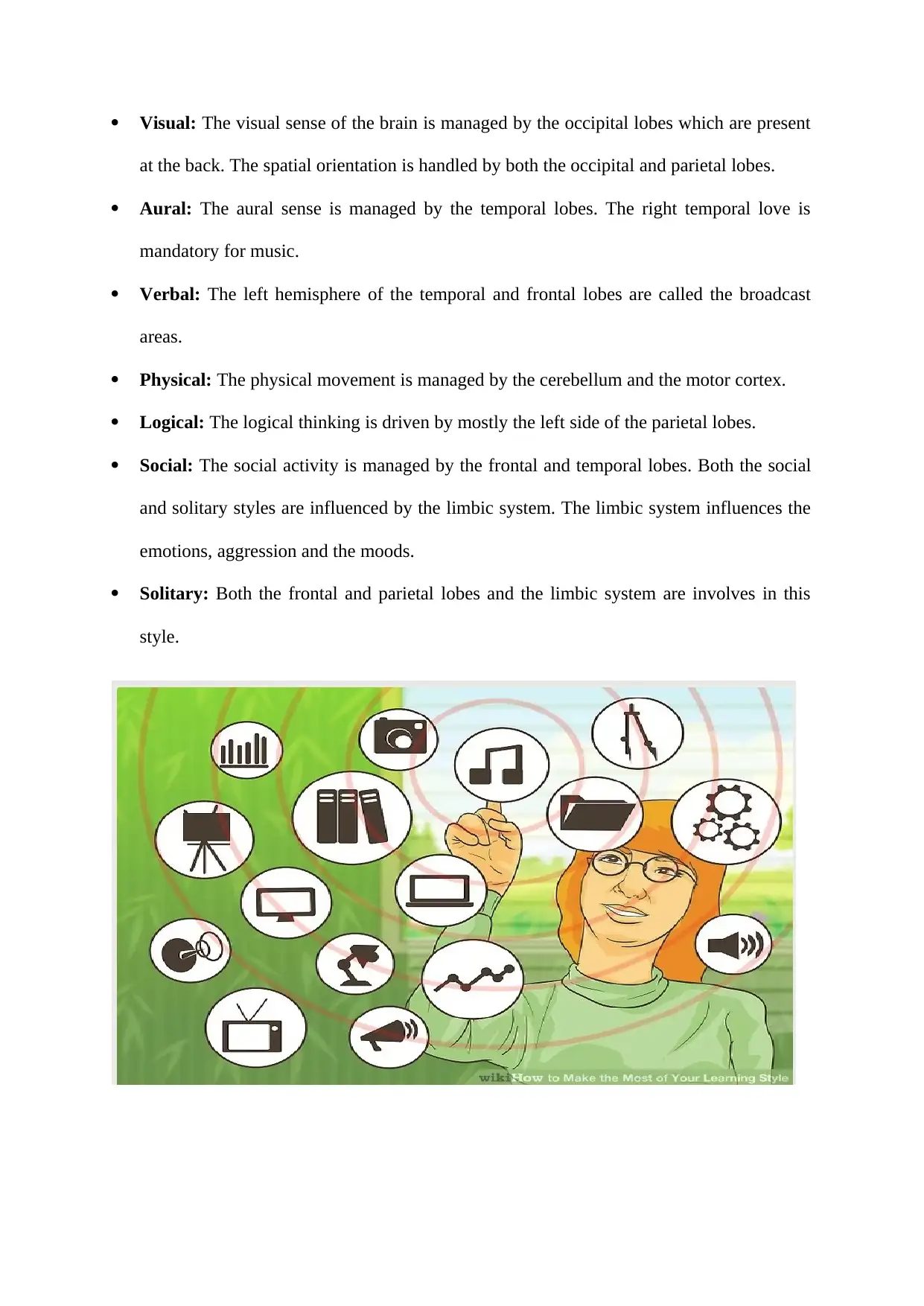
Visual: The visual sense of the brain is managed by the occipital lobes which are present
at the back. The spatial orientation is handled by both the occipital and parietal lobes.
Aural: The aural sense is managed by the temporal lobes. The right temporal love is
mandatory for music.
Verbal: The left hemisphere of the temporal and frontal lobes are called the broadcast
areas.
Physical: The physical movement is managed by the cerebellum and the motor cortex.
Logical: The logical thinking is driven by mostly the left side of the parietal lobes.
Social: The social activity is managed by the frontal and temporal lobes. Both the social
and solitary styles are influenced by the limbic system. The limbic system influences the
emotions, aggression and the moods.
Solitary: Both the frontal and parietal lobes and the limbic system are involves in this
style.
at the back. The spatial orientation is handled by both the occipital and parietal lobes.
Aural: The aural sense is managed by the temporal lobes. The right temporal love is
mandatory for music.
Verbal: The left hemisphere of the temporal and frontal lobes are called the broadcast
areas.
Physical: The physical movement is managed by the cerebellum and the motor cortex.
Logical: The logical thinking is driven by mostly the left side of the parietal lobes.
Social: The social activity is managed by the frontal and temporal lobes. Both the social
and solitary styles are influenced by the limbic system. The limbic system influences the
emotions, aggression and the moods.
Solitary: Both the frontal and parietal lobes and the limbic system are involves in this
style.
Paraphrase This Document
Need a fresh take? Get an instant paraphrase of this document with our AI Paraphraser
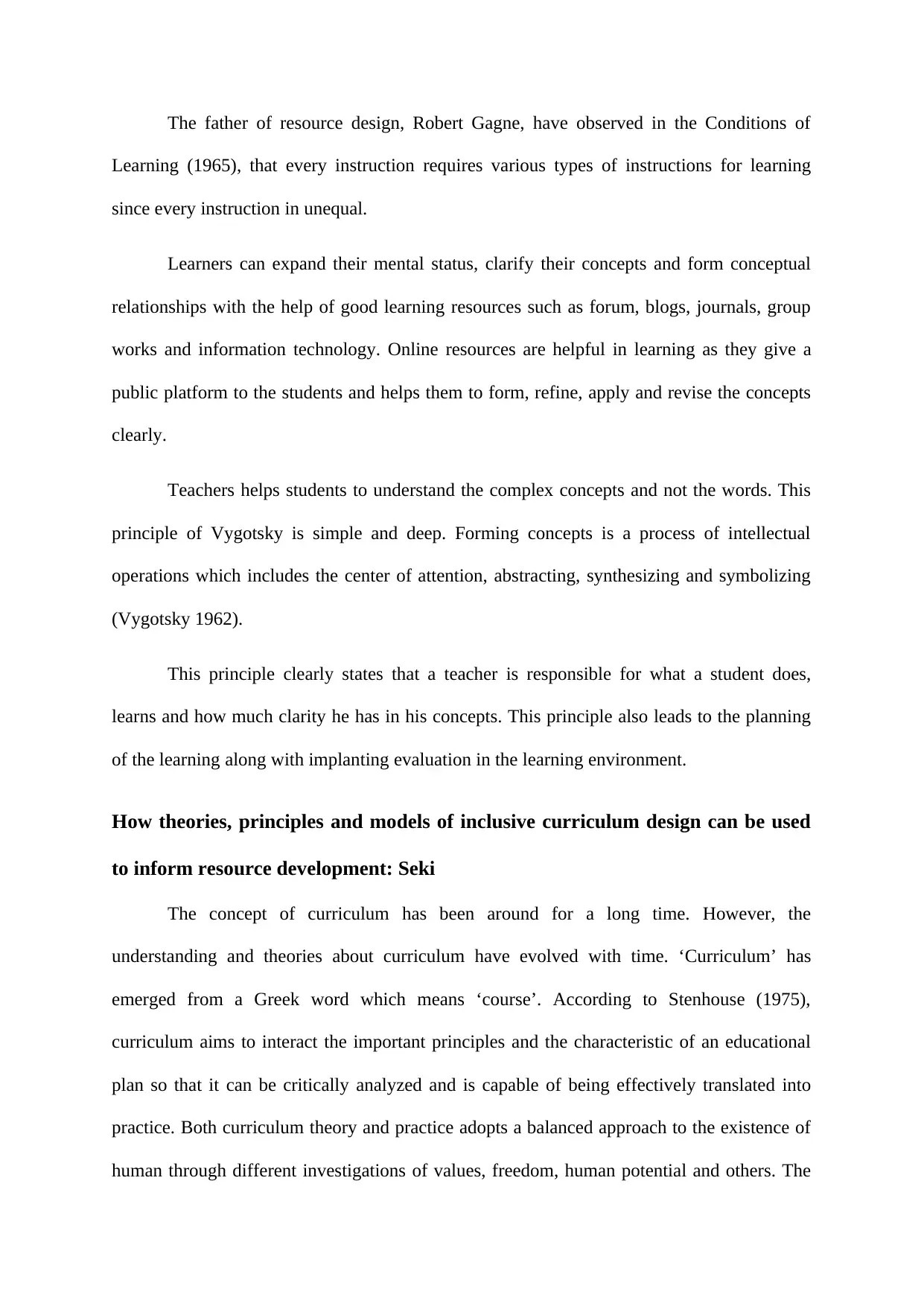
The father of resource design, Robert Gagne, have observed in the Conditions of
Learning (1965), that every instruction requires various types of instructions for learning
since every instruction in unequal.
Learners can expand their mental status, clarify their concepts and form conceptual
relationships with the help of good learning resources such as forum, blogs, journals, group
works and information technology. Online resources are helpful in learning as they give a
public platform to the students and helps them to form, refine, apply and revise the concepts
clearly.
Teachers helps students to understand the complex concepts and not the words. This
principle of Vygotsky is simple and deep. Forming concepts is a process of intellectual
operations which includes the center of attention, abstracting, synthesizing and symbolizing
(Vygotsky 1962).
This principle clearly states that a teacher is responsible for what a student does,
learns and how much clarity he has in his concepts. This principle also leads to the planning
of the learning along with implanting evaluation in the learning environment.
How theories, principles and models of inclusive curriculum design can be used
to inform resource development: Seki
The concept of curriculum has been around for a long time. However, the
understanding and theories about curriculum have evolved with time. ‘Curriculum’ has
emerged from a Greek word which means ‘course’. According to Stenhouse (1975),
curriculum aims to interact the important principles and the characteristic of an educational
plan so that it can be critically analyzed and is capable of being effectively translated into
practice. Both curriculum theory and practice adopts a balanced approach to the existence of
human through different investigations of values, freedom, human potential and others. The
Learning (1965), that every instruction requires various types of instructions for learning
since every instruction in unequal.
Learners can expand their mental status, clarify their concepts and form conceptual
relationships with the help of good learning resources such as forum, blogs, journals, group
works and information technology. Online resources are helpful in learning as they give a
public platform to the students and helps them to form, refine, apply and revise the concepts
clearly.
Teachers helps students to understand the complex concepts and not the words. This
principle of Vygotsky is simple and deep. Forming concepts is a process of intellectual
operations which includes the center of attention, abstracting, synthesizing and symbolizing
(Vygotsky 1962).
This principle clearly states that a teacher is responsible for what a student does,
learns and how much clarity he has in his concepts. This principle also leads to the planning
of the learning along with implanting evaluation in the learning environment.
How theories, principles and models of inclusive curriculum design can be used
to inform resource development: Seki
The concept of curriculum has been around for a long time. However, the
understanding and theories about curriculum have evolved with time. ‘Curriculum’ has
emerged from a Greek word which means ‘course’. According to Stenhouse (1975),
curriculum aims to interact the important principles and the characteristic of an educational
plan so that it can be critically analyzed and is capable of being effectively translated into
practice. Both curriculum theory and practice adopts a balanced approach to the existence of
human through different investigations of values, freedom, human potential and others. The
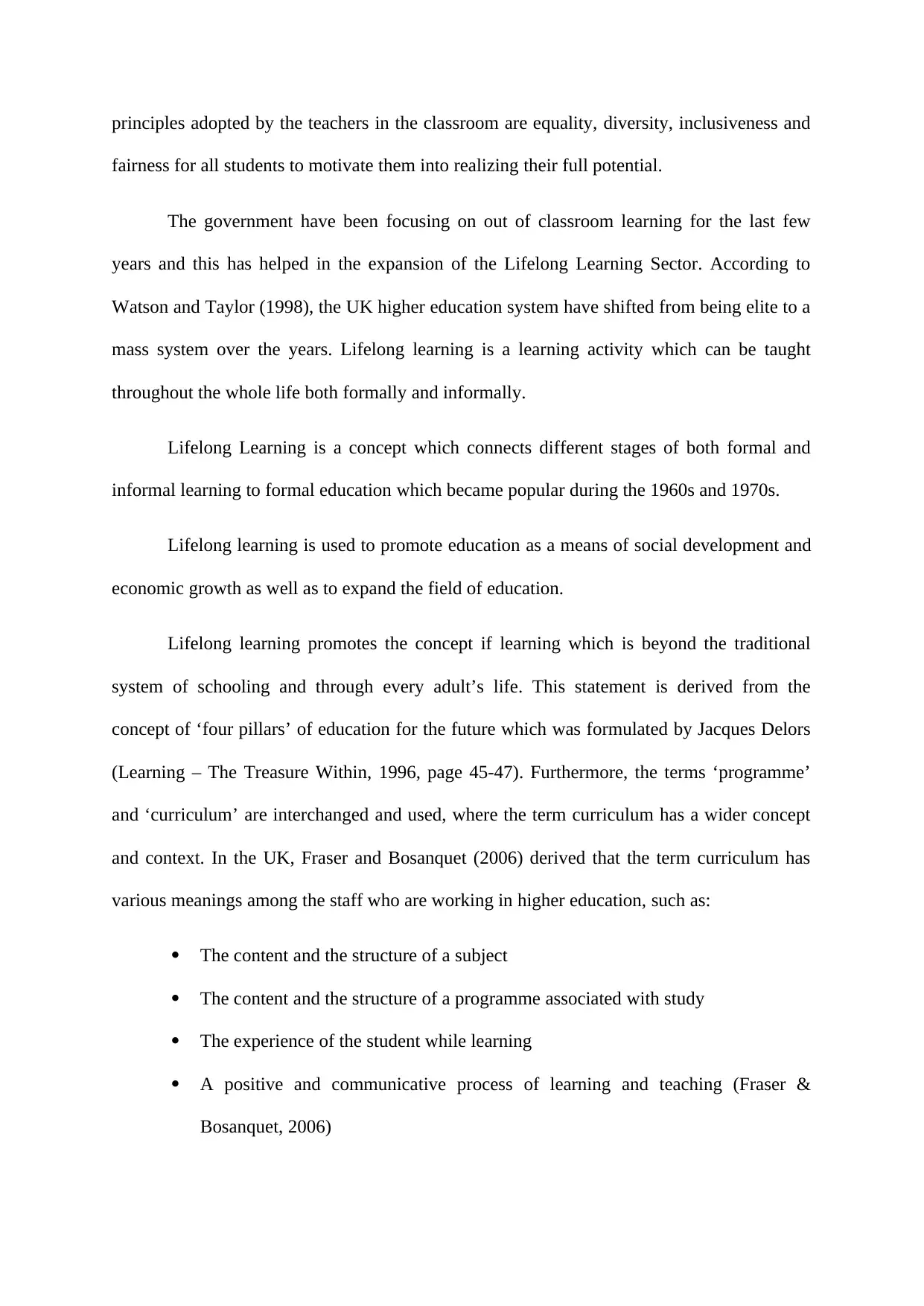
principles adopted by the teachers in the classroom are equality, diversity, inclusiveness and
fairness for all students to motivate them into realizing their full potential.
The government have been focusing on out of classroom learning for the last few
years and this has helped in the expansion of the Lifelong Learning Sector. According to
Watson and Taylor (1998), the UK higher education system have shifted from being elite to a
mass system over the years. Lifelong learning is a learning activity which can be taught
throughout the whole life both formally and informally.
Lifelong Learning is a concept which connects different stages of both formal and
informal learning to formal education which became popular during the 1960s and 1970s.
Lifelong learning is used to promote education as a means of social development and
economic growth as well as to expand the field of education.
Lifelong learning promotes the concept if learning which is beyond the traditional
system of schooling and through every adult’s life. This statement is derived from the
concept of ‘four pillars’ of education for the future which was formulated by Jacques Delors
(Learning – The Treasure Within, 1996, page 45-47). Furthermore, the terms ‘programme’
and ‘curriculum’ are interchanged and used, where the term curriculum has a wider concept
and context. In the UK, Fraser and Bosanquet (2006) derived that the term curriculum has
various meanings among the staff who are working in higher education, such as:
The content and the structure of a subject
The content and the structure of a programme associated with study
The experience of the student while learning
A positive and communicative process of learning and teaching (Fraser &
Bosanquet, 2006)
fairness for all students to motivate them into realizing their full potential.
The government have been focusing on out of classroom learning for the last few
years and this has helped in the expansion of the Lifelong Learning Sector. According to
Watson and Taylor (1998), the UK higher education system have shifted from being elite to a
mass system over the years. Lifelong learning is a learning activity which can be taught
throughout the whole life both formally and informally.
Lifelong Learning is a concept which connects different stages of both formal and
informal learning to formal education which became popular during the 1960s and 1970s.
Lifelong learning is used to promote education as a means of social development and
economic growth as well as to expand the field of education.
Lifelong learning promotes the concept if learning which is beyond the traditional
system of schooling and through every adult’s life. This statement is derived from the
concept of ‘four pillars’ of education for the future which was formulated by Jacques Delors
(Learning – The Treasure Within, 1996, page 45-47). Furthermore, the terms ‘programme’
and ‘curriculum’ are interchanged and used, where the term curriculum has a wider concept
and context. In the UK, Fraser and Bosanquet (2006) derived that the term curriculum has
various meanings among the staff who are working in higher education, such as:
The content and the structure of a subject
The content and the structure of a programme associated with study
The experience of the student while learning
A positive and communicative process of learning and teaching (Fraser &
Bosanquet, 2006)
⊘ This is a preview!⊘
Do you want full access?
Subscribe today to unlock all pages.

Trusted by 1+ million students worldwide
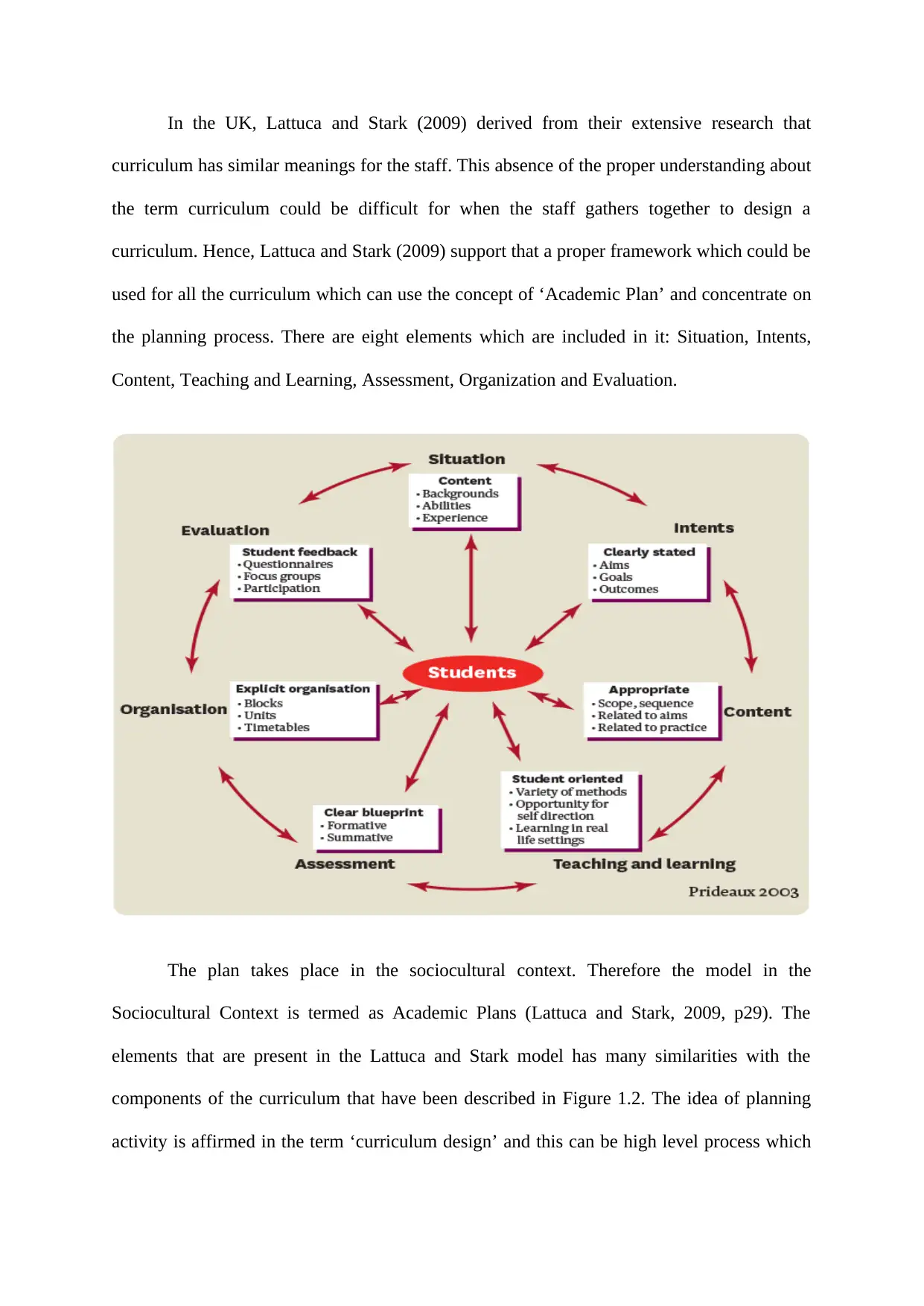
In the UK, Lattuca and Stark (2009) derived from their extensive research that
curriculum has similar meanings for the staff. This absence of the proper understanding about
the term curriculum could be difficult for when the staff gathers together to design a
curriculum. Hence, Lattuca and Stark (2009) support that a proper framework which could be
used for all the curriculum which can use the concept of ‘Academic Plan’ and concentrate on
the planning process. There are eight elements which are included in it: Situation, Intents,
Content, Teaching and Learning, Assessment, Organization and Evaluation.
The plan takes place in the sociocultural context. Therefore the model in the
Sociocultural Context is termed as Academic Plans (Lattuca and Stark, 2009, p29). The
elements that are present in the Lattuca and Stark model has many similarities with the
components of the curriculum that have been described in Figure 1.2. The idea of planning
activity is affirmed in the term ‘curriculum design’ and this can be high level process which
curriculum has similar meanings for the staff. This absence of the proper understanding about
the term curriculum could be difficult for when the staff gathers together to design a
curriculum. Hence, Lattuca and Stark (2009) support that a proper framework which could be
used for all the curriculum which can use the concept of ‘Academic Plan’ and concentrate on
the planning process. There are eight elements which are included in it: Situation, Intents,
Content, Teaching and Learning, Assessment, Organization and Evaluation.
The plan takes place in the sociocultural context. Therefore the model in the
Sociocultural Context is termed as Academic Plans (Lattuca and Stark, 2009, p29). The
elements that are present in the Lattuca and Stark model has many similarities with the
components of the curriculum that have been described in Figure 1.2. The idea of planning
activity is affirmed in the term ‘curriculum design’ and this can be high level process which
Paraphrase This Document
Need a fresh take? Get an instant paraphrase of this document with our AI Paraphraser
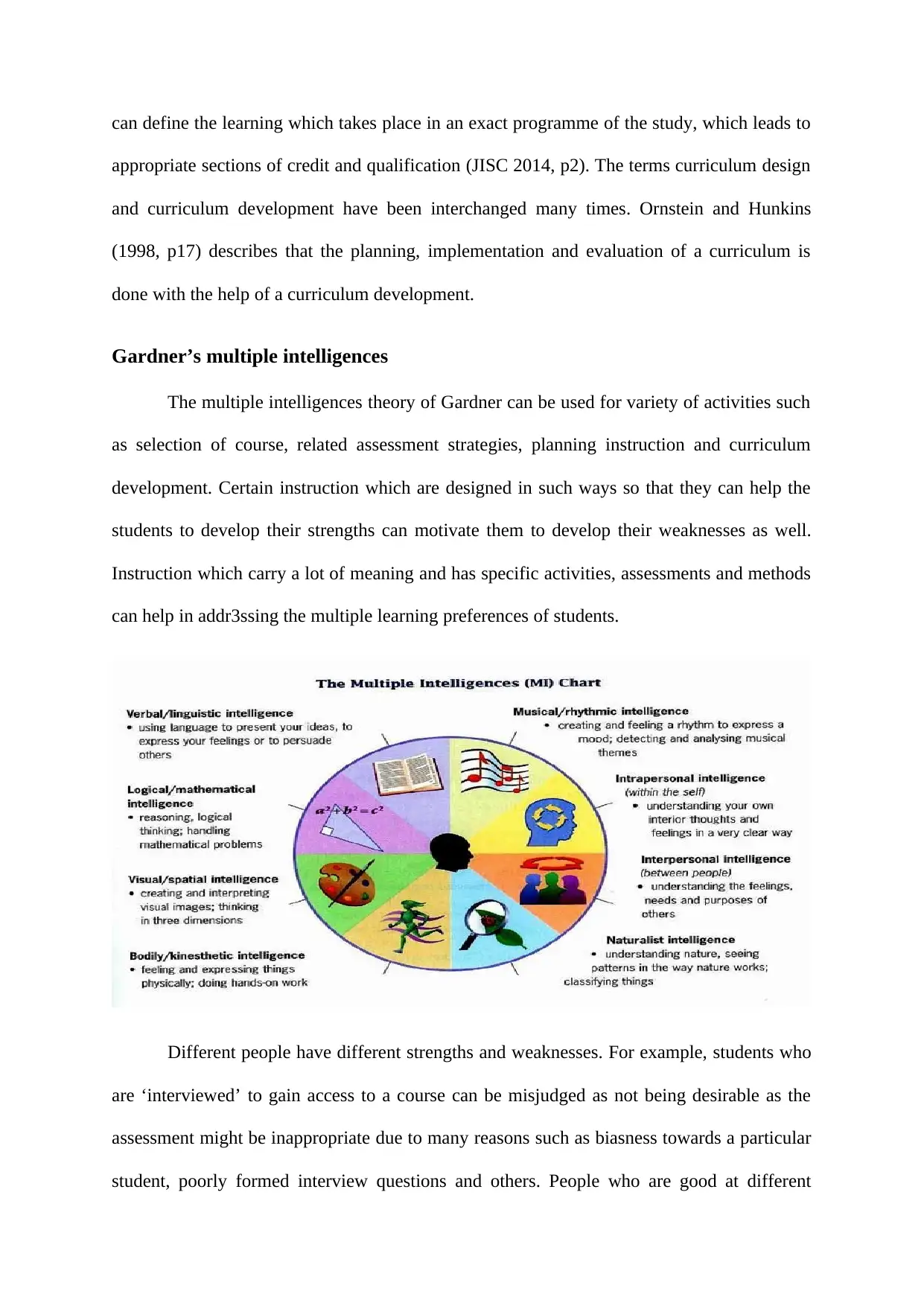
can define the learning which takes place in an exact programme of the study, which leads to
appropriate sections of credit and qualification (JISC 2014, p2). The terms curriculum design
and curriculum development have been interchanged many times. Ornstein and Hunkins
(1998, p17) describes that the planning, implementation and evaluation of a curriculum is
done with the help of a curriculum development.
Gardner’s multiple intelligences
The multiple intelligences theory of Gardner can be used for variety of activities such
as selection of course, related assessment strategies, planning instruction and curriculum
development. Certain instruction which are designed in such ways so that they can help the
students to develop their strengths can motivate them to develop their weaknesses as well.
Instruction which carry a lot of meaning and has specific activities, assessments and methods
can help in addr3ssing the multiple learning preferences of students.
Different people have different strengths and weaknesses. For example, students who
are ‘interviewed’ to gain access to a course can be misjudged as not being desirable as the
assessment might be inappropriate due to many reasons such as biasness towards a particular
student, poorly formed interview questions and others. People who are good at different
appropriate sections of credit and qualification (JISC 2014, p2). The terms curriculum design
and curriculum development have been interchanged many times. Ornstein and Hunkins
(1998, p17) describes that the planning, implementation and evaluation of a curriculum is
done with the help of a curriculum development.
Gardner’s multiple intelligences
The multiple intelligences theory of Gardner can be used for variety of activities such
as selection of course, related assessment strategies, planning instruction and curriculum
development. Certain instruction which are designed in such ways so that they can help the
students to develop their strengths can motivate them to develop their weaknesses as well.
Instruction which carry a lot of meaning and has specific activities, assessments and methods
can help in addr3ssing the multiple learning preferences of students.
Different people have different strengths and weaknesses. For example, students who
are ‘interviewed’ to gain access to a course can be misjudged as not being desirable as the
assessment might be inappropriate due to many reasons such as biasness towards a particular
student, poorly formed interview questions and others. People who are good at different

things collectively are required in life. People who possess different sets of intelligences are
the ones who build a well-balanced world and organization. This helps the team to have a full
collective capacity than the ones who share same intelligences (businessballs.com, 2009).
1. Verbal-linguistic intelligence – Can use words effectively as they have high auditory
skills and are sensitive to words.
2. Logical-mathematical intelligence – Able to think intellectually and conceptually and are
able to recognize numerical patterns and logic.
3. Visual-spatial intelligence – Ability to understand with the help of drawings, verbal and
physical images.
4. Bodily-kinesthetic intelligence – Able to use the body effectively and have a deep sense
of body awareness.
5. Musical intelligence – Ability to show sensitivity to sound and music.
6. Interpersonal intelligence – Ability to understand and interact with others.
7. Intrapersonal intelligence – Ability to understand one’s own goals, interests and desires.
8. Naturalist intelligence – Able to segregate and recognize different plants, animals and
other natural objects.
9. Existential intelligence – Sensitive towards understanding deep and intellectual questions
about the existence of human beings (Source: Thirteen ed online, 2004).
Devising new resources
Hegarty Maths
Hegarty Maths is a platform which explains maths with the help of constructive
examples, necessary knowledge on the subject, videos followed by demonstrative assessment
which coordinate well with the videos and finally an uncomplicated tracking system which
enables teachers to keep a track on the mistakes of the students and also make it easy to
the ones who build a well-balanced world and organization. This helps the team to have a full
collective capacity than the ones who share same intelligences (businessballs.com, 2009).
1. Verbal-linguistic intelligence – Can use words effectively as they have high auditory
skills and are sensitive to words.
2. Logical-mathematical intelligence – Able to think intellectually and conceptually and are
able to recognize numerical patterns and logic.
3. Visual-spatial intelligence – Ability to understand with the help of drawings, verbal and
physical images.
4. Bodily-kinesthetic intelligence – Able to use the body effectively and have a deep sense
of body awareness.
5. Musical intelligence – Ability to show sensitivity to sound and music.
6. Interpersonal intelligence – Ability to understand and interact with others.
7. Intrapersonal intelligence – Ability to understand one’s own goals, interests and desires.
8. Naturalist intelligence – Able to segregate and recognize different plants, animals and
other natural objects.
9. Existential intelligence – Sensitive towards understanding deep and intellectual questions
about the existence of human beings (Source: Thirteen ed online, 2004).
Devising new resources
Hegarty Maths
Hegarty Maths is a platform which explains maths with the help of constructive
examples, necessary knowledge on the subject, videos followed by demonstrative assessment
which coordinate well with the videos and finally an uncomplicated tracking system which
enables teachers to keep a track on the mistakes of the students and also make it easy to
⊘ This is a preview!⊘
Do you want full access?
Subscribe today to unlock all pages.

Trusted by 1+ million students worldwide
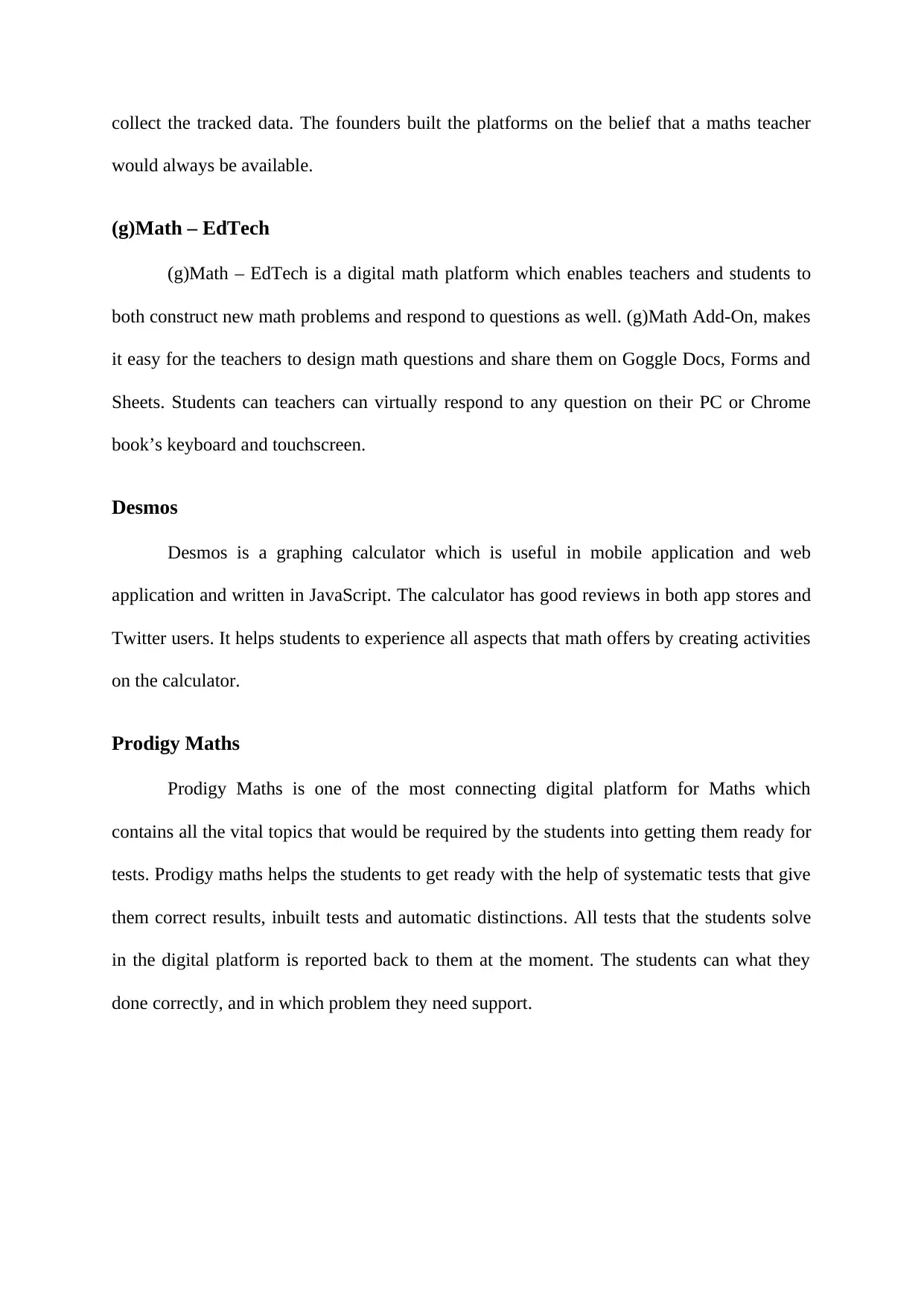
collect the tracked data. The founders built the platforms on the belief that a maths teacher
would always be available.
(g)Math – EdTech
(g)Math – EdTech is a digital math platform which enables teachers and students to
both construct new math problems and respond to questions as well. (g)Math Add-On, makes
it easy for the teachers to design math questions and share them on Goggle Docs, Forms and
Sheets. Students can teachers can virtually respond to any question on their PC or Chrome
book’s keyboard and touchscreen.
Desmos
Desmos is a graphing calculator which is useful in mobile application and web
application and written in JavaScript. The calculator has good reviews in both app stores and
Twitter users. It helps students to experience all aspects that math offers by creating activities
on the calculator.
Prodigy Maths
Prodigy Maths is one of the most connecting digital platform for Maths which
contains all the vital topics that would be required by the students into getting them ready for
tests. Prodigy maths helps the students to get ready with the help of systematic tests that give
them correct results, inbuilt tests and automatic distinctions. All tests that the students solve
in the digital platform is reported back to them at the moment. The students can what they
done correctly, and in which problem they need support.
would always be available.
(g)Math – EdTech
(g)Math – EdTech is a digital math platform which enables teachers and students to
both construct new math problems and respond to questions as well. (g)Math Add-On, makes
it easy for the teachers to design math questions and share them on Goggle Docs, Forms and
Sheets. Students can teachers can virtually respond to any question on their PC or Chrome
book’s keyboard and touchscreen.
Desmos
Desmos is a graphing calculator which is useful in mobile application and web
application and written in JavaScript. The calculator has good reviews in both app stores and
Twitter users. It helps students to experience all aspects that math offers by creating activities
on the calculator.
Prodigy Maths
Prodigy Maths is one of the most connecting digital platform for Maths which
contains all the vital topics that would be required by the students into getting them ready for
tests. Prodigy maths helps the students to get ready with the help of systematic tests that give
them correct results, inbuilt tests and automatic distinctions. All tests that the students solve
in the digital platform is reported back to them at the moment. The students can what they
done correctly, and in which problem they need support.
Paraphrase This Document
Need a fresh take? Get an instant paraphrase of this document with our AI Paraphraser
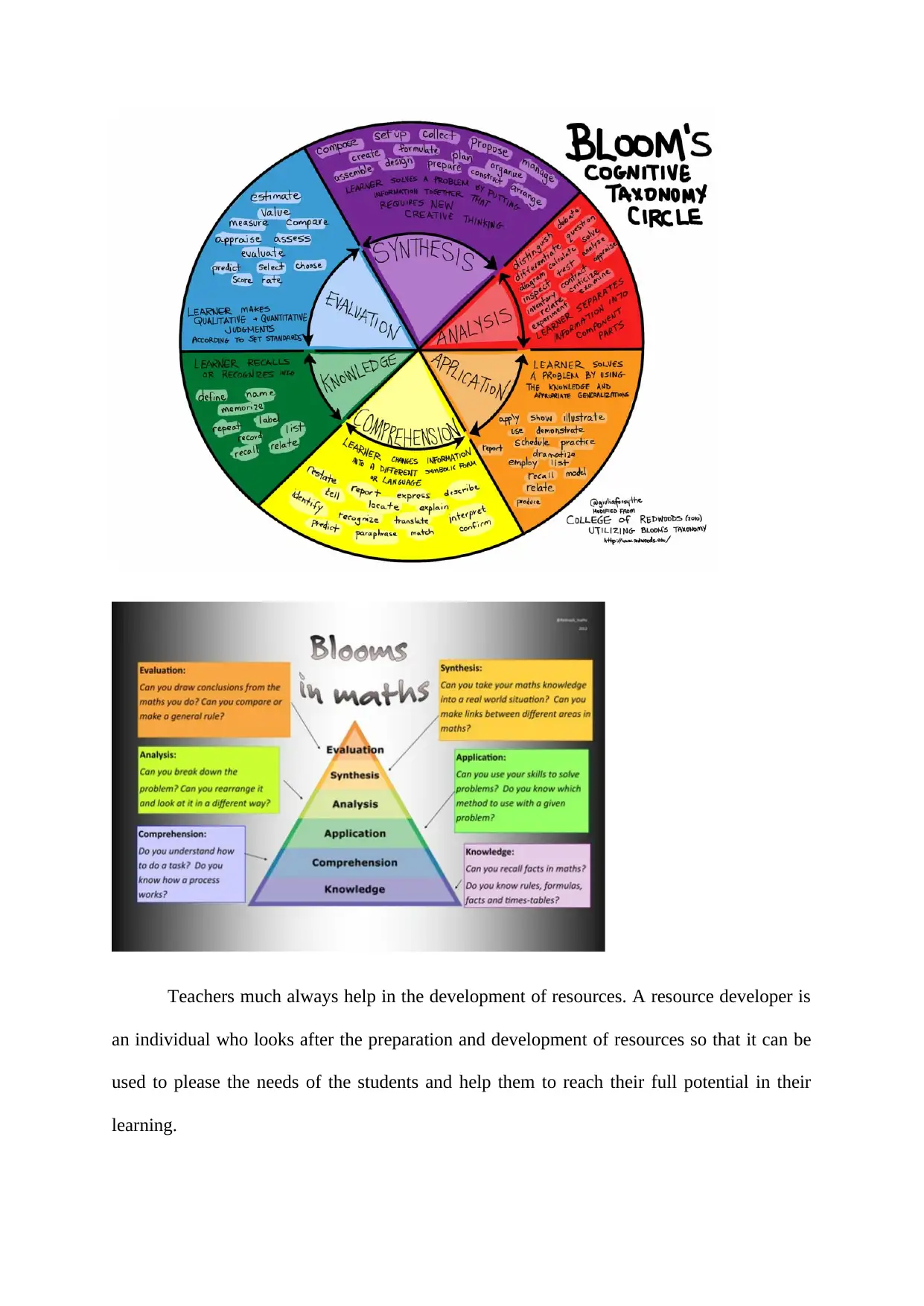
Teachers much always help in the development of resources. A resource developer is
an individual who looks after the preparation and development of resources so that it can be
used to please the needs of the students and help them to reach their full potential in their
learning.
an individual who looks after the preparation and development of resources so that it can be
used to please the needs of the students and help them to reach their full potential in their
learning.
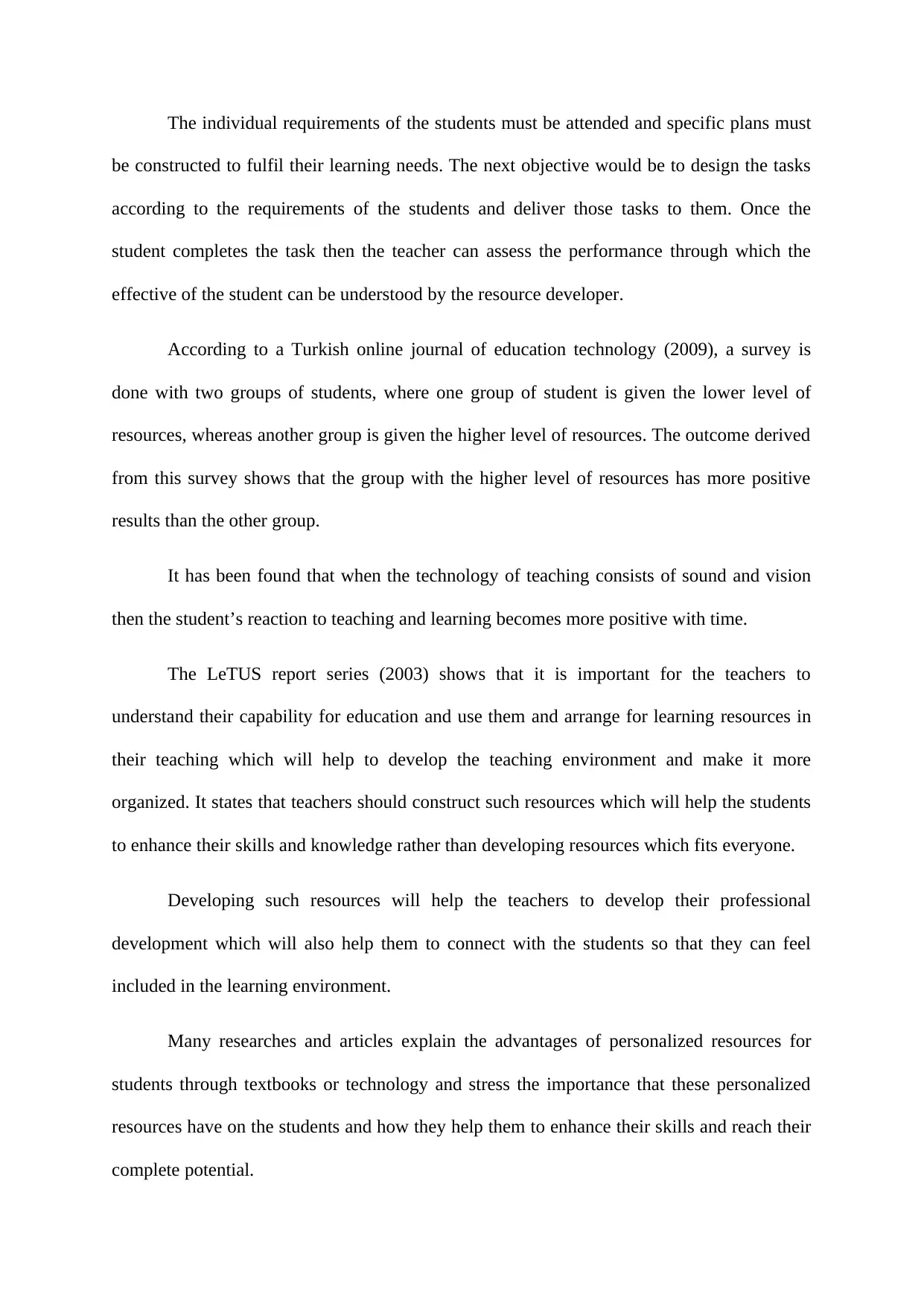
The individual requirements of the students must be attended and specific plans must
be constructed to fulfil their learning needs. The next objective would be to design the tasks
according to the requirements of the students and deliver those tasks to them. Once the
student completes the task then the teacher can assess the performance through which the
effective of the student can be understood by the resource developer.
According to a Turkish online journal of education technology (2009), a survey is
done with two groups of students, where one group of student is given the lower level of
resources, whereas another group is given the higher level of resources. The outcome derived
from this survey shows that the group with the higher level of resources has more positive
results than the other group.
It has been found that when the technology of teaching consists of sound and vision
then the student’s reaction to teaching and learning becomes more positive with time.
The LeTUS report series (2003) shows that it is important for the teachers to
understand their capability for education and use them and arrange for learning resources in
their teaching which will help to develop the teaching environment and make it more
organized. It states that teachers should construct such resources which will help the students
to enhance their skills and knowledge rather than developing resources which fits everyone.
Developing such resources will help the teachers to develop their professional
development which will also help them to connect with the students so that they can feel
included in the learning environment.
Many researches and articles explain the advantages of personalized resources for
students through textbooks or technology and stress the importance that these personalized
resources have on the students and how they help them to enhance their skills and reach their
complete potential.
be constructed to fulfil their learning needs. The next objective would be to design the tasks
according to the requirements of the students and deliver those tasks to them. Once the
student completes the task then the teacher can assess the performance through which the
effective of the student can be understood by the resource developer.
According to a Turkish online journal of education technology (2009), a survey is
done with two groups of students, where one group of student is given the lower level of
resources, whereas another group is given the higher level of resources. The outcome derived
from this survey shows that the group with the higher level of resources has more positive
results than the other group.
It has been found that when the technology of teaching consists of sound and vision
then the student’s reaction to teaching and learning becomes more positive with time.
The LeTUS report series (2003) shows that it is important for the teachers to
understand their capability for education and use them and arrange for learning resources in
their teaching which will help to develop the teaching environment and make it more
organized. It states that teachers should construct such resources which will help the students
to enhance their skills and knowledge rather than developing resources which fits everyone.
Developing such resources will help the teachers to develop their professional
development which will also help them to connect with the students so that they can feel
included in the learning environment.
Many researches and articles explain the advantages of personalized resources for
students through textbooks or technology and stress the importance that these personalized
resources have on the students and how they help them to enhance their skills and reach their
complete potential.
⊘ This is a preview!⊘
Do you want full access?
Subscribe today to unlock all pages.

Trusted by 1+ million students worldwide
1 out of 16
Related Documents
Your All-in-One AI-Powered Toolkit for Academic Success.
+13062052269
info@desklib.com
Available 24*7 on WhatsApp / Email
![[object Object]](/_next/static/media/star-bottom.7253800d.svg)
Unlock your academic potential
Copyright © 2020–2025 A2Z Services. All Rights Reserved. Developed and managed by ZUCOL.



